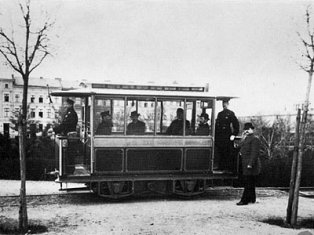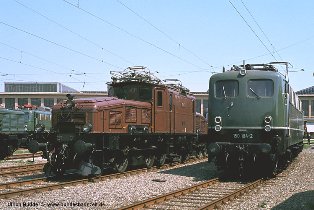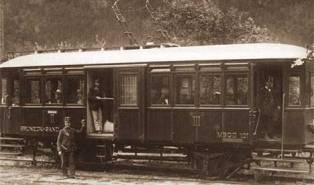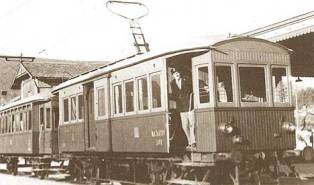The history of electrification of railways. Part 1
In the last quarter of the XIX century. The outlines of new directions of locomotive construction-electric locomotives and diesel locomotive building-were outlined.
The possibility of applying electric traction on the railways was indicated back in 1874 in the application for a privilege by the Russian specialist FA Pirotsky. In the years 1875-1876. He conducted experiments on the Sestroretsk railway on the transmission of electricity on the rails isolated from the ground. The transmission was carried out over a distance of about 1 km. The second rail was used as the return wire. Electric power was transferred to a small engine. In August 1876, FA Pirotsky placed an article in the Engineering Journal with the results of his work. These experiments led him to think of using electric power for trolleys moving along metal rails.
Practical realization of the idea of using electric energy in transport belongs to Werner Simens (Germany), who built the first electric railway, which was exhibited at the Berlin industrial exhibition in 1879. It represented a small narrow-gauge railway, intended for visitors' walks. A short train of open carriages was set in motion by an electric locomotive with two motors, which received a constant current of 150 V from the iron strip laid between the rails. The return wire was one of the running rails.

In 1881, Mr .. Simens built a test plot of an electric road in the suburbs of Berlin Lichterfelde, first applying a motor car. A current of 180 V was applied to one of the running rails, and the other rail served as a return wire.
In order to avoid large losses of electric power, which arose because of the poor insulating ability of wooden sleepers, V. Siemens decided to change the electrical circuit of the electric motor. For this purpose, a suspended working wire was used on the electric road, built in the same year in 1881 at the World Paris Exhibition. He represented an iron pipe suspended above the rails. The lower part of the tube was equipped with a longitudinal slot. Inside the tube went the shuttle, connected through a slot with a flexible wire that was attached to the roof of the locomotive and transmitted electric current to the electric motor. The same tube, suspended next to the first, served as a return wire. A similar system was applied to the buildings built in 1883-1884. Suburban trams Mödling - Forderbrül in Austria and Frankfurt - Offenbach in Germany, operating at 350 V.
Approximately at the same time in Kinreshe (Ireland) on the tram line was used to conduct current on the third rail, which was installed on the insulators next to the running rails. However, this system was completely unacceptable in the city, interfering with the movement of crews and pedestrians.
It is interesting to note that FA Pirotsky, who wrote in 1880 in the St. Petersburg Newspaper, predicted the technical doom of such a system for supplying electric current to the motor: "The electrical railway constructed by me is the simplest and cheapest. It does not require the cost of an average rail line, in vain increasing the cost of the road by 5% and stopping the traffic in the city. It does not require costs and on cast-iron poles, which are excessively expensive. "
This letter was published by Pirotsky in connection with the reports in the press about the results of the electric tram tests he conducted on September 3, 1880 in St. Petersburg. At this time FA Pirotsky was intensively engaged in the implementation of his projects related to the creation of reliable urban electric transport. He understood that the development of trunk railway electric transport is impossible without solving the fundamental problem of electrical engineering - the transmission of electricity over long distances. Taking this into account, FA Pirotsky concentrated his attention on the experiments of electromotion of a car adopted on urban horse-railroads. As a result, in 1880 he managed to make the first movement along the rails of a real two-tier motor car. The results of his work FA Pirotsky presented in 1881 at the International Electrical Exhibition in Paris, where he exhibited his scheme of the electric railway.

In 1884, in Brighton (England), an electric railway was constructed according to the Pyrotsky scheme, powered by one of the rails, 7 miles long. The operation of only one wagon gave a net profit, compared to a horse pull of 420 francs a day.
Since the mid-eighties of the XIX century. The development of electric traction on the railways is beginning to be intensively pursued by American engineers and entrepreneurs who have vigorously set about the improvement of electric locomobiles, as well as the ways of connecting the current.
TA Edison, working in the USA, worked on the problem of electric railway transport, and he built three small experimental lines during the period from 1880 to 1884. In 1880, he created an electric locomotive, which in its appearance resembled a locomotive. The electric locomotive was powered by electric current from the track rails, one of which was connected to the positive one and the other to the negative pole of the generator. In 1883, TA Edison, together with SD Field, built a more advanced electric vehicle ("The Judge"), exhibited at an exhibition in Chicago and later in Louisville.
By 1883, the work of the American engineer L. Daft, who created the first trunk electric locomotive ("Atrug") for the standard gauge, is intended for the Saratoga-McGregor railway. In 1885, Daft built an improved model of an electric locomotive for the New York overpass railroad. The locomotive, named "Benjamin Franklin", weighed 10 tons, had a length of more than 4 meters and was equipped with four driving wheels. An electric current of 250 V was supplied via a third rail to a 125-liter motor. S, which could pull a train of eight cars at a speed of 10 miles per hour (16 km / h).
In 1884 the Swiss engineer R. Tori built an experimental railroad with a serrated gear, combining with her help a hotel on the mountainside with a place called Terry (near Montreux on the Lake Geneva). The locomotive had four driving wheels and moved along a very steep slope (1: 33). Its power was small and allowed to carry four passengers at the same time. On the descent in the process of braking the motor worked as a generator, returning electric energy to the grid.
For a number of years, engineering thought has worked tirelessly to improve the technique of supplying current to an electric locomotive.
In 1884 in Cleveland Bentley and Knight built a tram with an underground wire. A similar system was introduced in 1889 in Budapest. This method of power supply proved to be inconvenient in operation, as the trough quickly became contaminated.

At the end of 1884 in Kansas City (USA) Henry tested a system with copper air wires, one of which was straight, the other - the reverse one.
By 1885, the construction of the first tram with one air working wire by the Belgian specialist Van de Depou in Toronto, Canada. In his scheme, the back rails served as a return wire. Along the line, poles were built with consoles, to which insulators with a working wire were attached. Contact with the working wire was carried out using a metal roller, mounted on the tram bar, which during the movement "rolled" along the wire.
This suspension system proved to be very rational, after further improvement it was adopted in many other countries and soon received universal distribution. By 1890 in the US, there were about 2,500 km of electric tramway roads in operation, and by 1897, 25,000 km. The electric tram began to displace the old types of urban transport.
In 1890 an air wire appeared for the first time in Europe on the tramway line in Halle (Prussia). Since 1893 the electric railways in Europe have been developing at an accelerated pace, as a result of which, by 1900, their length has reached 10,000 km.
In 1890, electrical traction was applied on the lined underground London road. An electric current of 500 V was supplied to the motor by means of a third rail. This system was very successful for roads with a separate canvas and began to spread rapidly in other countries. One of its advantages is the possibility of electrification of roads with a very large consumption of electricity, which included metro and main railways.
In 1896 electric traction using a current-carrying third rail was first introduced on the section of the Baltimore-Ohai railway. Electrification touched a piece of road on the approach to Baltimore, 7 km long. A 2,5-kilometer tunnel was laid on this section of the road, prompting the builders to electrify it. Electric locomotives operating on this section received electrical energy from the third rail at a voltage of 600 V.
The first electrified railways were small in their length. The construction of railways of great length was faced with difficulties associated with large energy losses, which causes the transmission of a constant current for long distances. With the advent of AC transformers in the 1980s, which made it possible to transmit current over long distances, they were introduced into the power supply circuits of the railway mains.

With the introduction of transformers in the power supply system, a so-called "three-phase-direct current system" was formed, or, in other words, a "direct current system with a three-phase power transmission". The central electric station produced three-phase current. It was transformed into high voltage (from 5 to 15 thousand V, and in the 1920s - to 120 thousand V), which was fed to the relevant sections of the line. Each of them had its own lowering substation, from which alternating current was directed to an alternating current electric motor, mounted on one shaft with a direct current generator. From him the working wire was powered by electricity. In 1898, a significant railway along with an independent canvas and with a three-phase current system was built in Switzerland and connected Freiburg-Murten-Ince. It was followed by the electrification of a number of other sections of the railways and subways.
By 1905, electric traction completely replaced the steam on underground roads.
Shukhardin S. "Technology in its historical development"


Comments
When commenting on, remember that the content and tone of your message can hurt the feelings of real people, show respect and tolerance to your interlocutors even if you do not share their opinion, your behavior in the conditions of freedom of expression and anonymity provided by the Internet, changes Not only virtual, but also the real world. All comments are hidden from the index, spam is controlled.